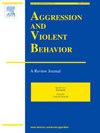非人化与侵略:一项元分析
IF 3.4
2区 心理学
Q1 CRIMINOLOGY & PENOLOGY
引用次数: 0
摘要
去人性化指的是认为人们不是完全的人,理论上认为这有助于侵略。到目前为止,已经有大量的实证研究直接或间接地检验了这种联系。目前的研究是进行系统的荟萃分析,以获得对这种关系的精确估计。更重要的是,我们的目标是研究这种关系是否进一步受到两种主要理论的影响,包括非人性化的形式(即公然与微妙,公然的非人性化理论)和类型(即动物主义与机械主义,双重模型)。基于184个效应量(32篇已发表和未发表的论文)。荟萃分析发现,去人性化与攻击之间存在中等总体效应(r = 0.34, 95% CI =[0.28, 0.41])。此外,与微妙的非人性化相比,公然的非人性化更大(r = 0.39, 95% CI = [0.30, 0.49], r = 0.31, 95% CI =[0.23, 0.39]),并且两种类型的非人性化(动物性和amp;机械师,r = 0.38, 95% CI =[0.24, 0.52]),相比单一类型(肉欲的,r = 0.26, 95% CI =[0.14, 0.37]或技师,r = 0.27, 95% CI =[0.15, 0.40])。已经讨论了影响。本文章由计算机程序翻译,如有差异,请以英文原文为准。
Dehumanization and aggression: A meta-analysis
Dehumanization refers to perceiving people as less than fully human and is theoretically argued to contribute to aggression. Till now, a large body of empirical studies have been conducted to test this link directly or indirectly. The current research is to conduct a systematic meta-analysis to obtain a precise estimation of this relationship. More importantly, we aim to examine whether this relationship is further subject to moderators capturing two prominent theories, including the form (i.e., blatant versus subtle, the blatant dehumanization theory) and the type (i.e., animalistic versus mechanical, the dual model) of dehumanization. Based on a total of 184 effect sizes (32 published and non-published papers). The meta-analysis found a moderate overall effect for the association between dehumanization and aggression (r = 0.34, 95 % CI = [0.28, 0.41]). In addition, the association was larger for blatant, compared to subtle (r = 0.39, 95 % CI = [0.30, 0.49] versus r = 0.31, 95 % CI = [0.23, 0.39]) dehumanization, and more robust for dehumanization in both types (animalistic & mechanic, r = 0.38, 95 % CI = [0.24, 0.52]), compared to a single type (animalistic, r = 0.26, 95 % CI = [0.14, 0.37] or mechanic, r = 0.27, 95 % CI = [0.15, 0.40]). Implications have been discussed.
求助全文
通过发布文献求助,成功后即可免费获取论文全文。
去求助
来源期刊

Aggression and Violent Behavior
Multiple-
CiteScore
7.50
自引率
4.30%
发文量
63
期刊介绍:
Aggression and Violent Behavior, A Review Journal is a multidisciplinary journal that publishes substantive and integrative reviews, as well as summary reports of innovative ongoing clinical research programs on a wide range of topics germane to the field of aggression and violent behavior. Papers encompass a large variety of issues, populations, and domains, including homicide (serial, spree, and mass murder: sexual homicide), sexual deviance and assault (rape, serial rape, child molestation, paraphilias), child and youth violence (firesetting, gang violence, juvenile sexual offending), family violence (child physical and sexual abuse, child neglect, incest, spouse and elder abuse), genetic predispositions, and the physiological basis of aggression.
 求助内容:
求助内容: 应助结果提醒方式:
应助结果提醒方式:


